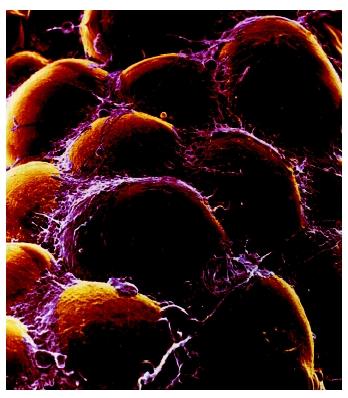Regulation of Adipocyte Function by Anthocyanins;
Possibility of Preventing the Metabolic Syndrome
TAKANORI TSUDA
The Journal of Agricultural and Food Chemistry
J. Agric. Food Chem. 2008, 56, 642–646
In this paper Takanori Tsuda addresses the beneficial aspects of anthocyanins, and their role in the regulation of adipocyte function. Anthocyanins are molecules contained in various plants that give them their colour, and are often found in the flowers and berries. This study looked at a specific anthocyanin, cyanidin 3-0-b-D-glucoside (C3G), which the study was able to show had both antioxidant and anti-inflammatory properties. The effect that this has on adipose tissue is however the most important part of this paper, as they were able to show that in mice, even in very low concentrations, C3G will have a very strong effect on the cells ability to store fat, even during high fat diets. Through the research as well, Tsuda was able to show how this might be able to help with what is known as metabolic syndrome, a combination of risk factors th e most important of which is central adiposity, which can be combated with this anthocyanin.
e most important of which is central adiposity, which can be combated with this anthocyanin.
 In the study Tsuda used male mice that were four months old, and created four different conditions to test the effectiveness of the C3G molecule. The first was a control and the second was a high fat diet, 30% of which was lard. The third and fourth used C3G rich Purple Corn Colour (PCC), one alone as a control for the compound and one in concert with the high fat diet. The findings showed that the mice fed on just the high fat diet gained considerably more weight than those not on the high fat diet, however those mice treated with PCC and on the high fat diet showed the same levels of fat deposition as those who had not been fed the high fat diet. The actual physical weight of the fat found in areas such as subcutaneous, epididymal and mesenteric, all showed much higher weights in the mice with only the high fat diet over the three other groups, all of which showed virtually the same weights on all three types of fat.
In the study Tsuda used male mice that were four months old, and created four different conditions to test the effectiveness of the C3G molecule. The first was a control and the second was a high fat diet, 30% of which was lard. The third and fourth used C3G rich Purple Corn Colour (PCC), one alone as a control for the compound and one in concert with the high fat diet. The findings showed that the mice fed on just the high fat diet gained considerably more weight than those not on the high fat diet, however those mice treated with PCC and on the high fat diet showed the same levels of fat deposition as those who had not been fed the high fat diet. The actual physical weight of the fat found in areas such as subcutaneous, epididymal and mesenteric, all showed much higher weights in the mice with only the high fat diet over the three other groups, all of which showed virtually the same weights on all three types of fat.
Another part of the study looked at how anthocyanins may affect gene expression. This was done by isolating preadiposities from humans and cultured them for 13 days at which time the introduced the mature adiposities to anthocyanins for a 24 hour period. The DNA of the adiposities was then analyzed using RNA microarrays, and this showed that two genes that both contributed to obesity and type two diabetes were both down regulated in the presence of the anthocyanins. The implications that this has for the treatment of metabolic syndrome are that concentrations of these anthocyanins may be able to help reduce large amounts of adipose tissue bring it to normal levels, which in turn would be able to help with the growing prevalence of type 2 diabetes.
Over all the paper was a well-written, well-researched work, however a critique could be made to originality. Though good experiments were carried out and the data that was presented was done well and showed great potential for future research, the author of the paper, Takanori Tsuda, relied very heavily on the research of others with it making up the bulk of his paper. A great deal of research was needed to properly explain a large portion of the work that had been done, however I feel that the explanations based on others work could have been shortened and at the same time more emphasis could have been put on his original research. There were also parts of the paper that talked about things not related to adipose and its interactions with the anthocyanins, where it went on to talk about AMP:ATP ratios and receptor genes that were not well tied into the overall paper that could have been better incorporated into the overall work or omitted all together for the sake of clarity. These critiques aside however, I feel that this would be a great area for further research into the potential research applications of anthocyanins and the effectiveness of these molecules on humans.

